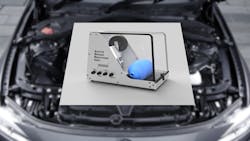Researchers Build a Ventilator Using an Automotive Motor
A research team at The University of Texas at Austin is building a ventilator made of cheap, widely available materials to help fill the demand created by the spread of COVID-19.
The device, called the Austin Bridge Breathing Unit, uses a manual resuscitator, a common handheld device with an AMBU (artificial medical breathing unit) bag. It fills up with oxygen to help patients breathe. Unfortunately, a medical professional must repeatedly squeeze the bag to help patients inhale the oxygen—a challenge when medical personnel across the country are stretched thin due to the coronavirus.
So, the researchers needed a way to automatically compress the bag, and they found it in a windshield-wiper motor pulled from a Toyota Camry. The team repurposed the motor to power a small caster wheel that pushes down on the bag to control oxygen flow. Four potentiometers control the respiration rate, volume of oxygen given to patients, the time period to inhale and the maximum pressure.
The team came up with the idea to use the motor during a brainstorming session. The advantages of these motors are that they’re available, reliable and inexpensive. They are extensively tested as part of the automobile production process. To quickly figure out the motor, the team worked with a local mechanic.
The team is currently testing the prototype on a manikin from UT’s Dell Medical School and test lungs provided by UT Health San Antonio.
Once the prototype is checked, the researchers will provide an open license to the design so anyone can make their own low-cost, reliable ventilator. Along with a team from Dell Medical School, they are also talking with several manufacturing partners about quickly building at least 2,000 ventilators.
The device’s components are all regulated individually, so the team hopes approval can come in a matter of weeks rather than months. Just recently, the FDA issued an Emergency Use Authorization protocol to speed production of ventilators and other respiratory devices.
The University of Texas at Austin quickly pivoted to COVID-19 projects after most research was shut down by the pandemic. Another recent example of that effort came out of the University of Minnesota last week, when a cardiac anesthesiologist went “full-on MacGyver,” building a ventilator prototype out of $150 worth of spare parts found in a medical device lab.

